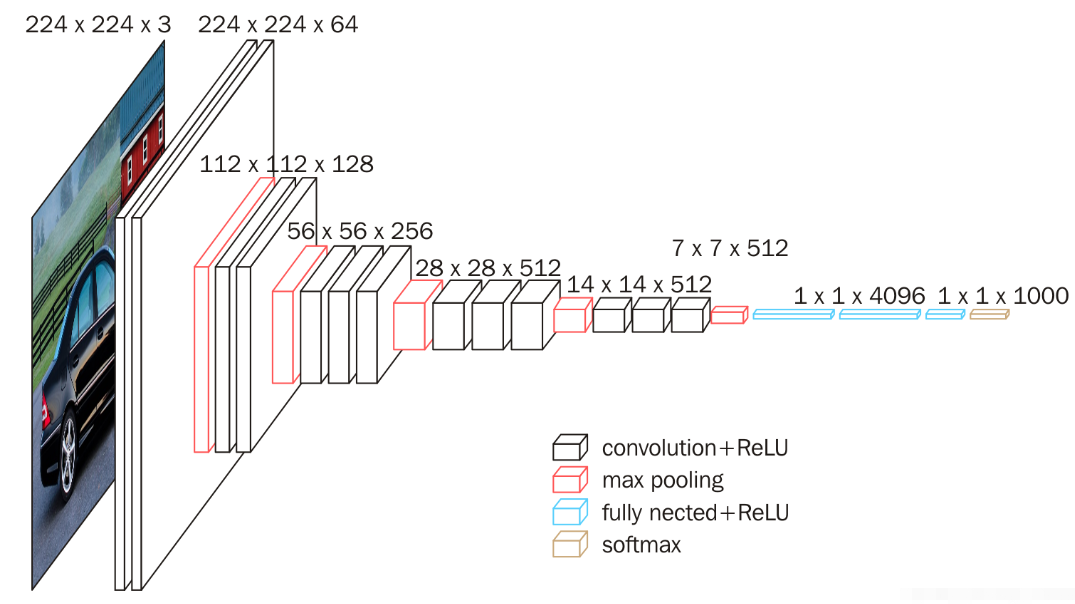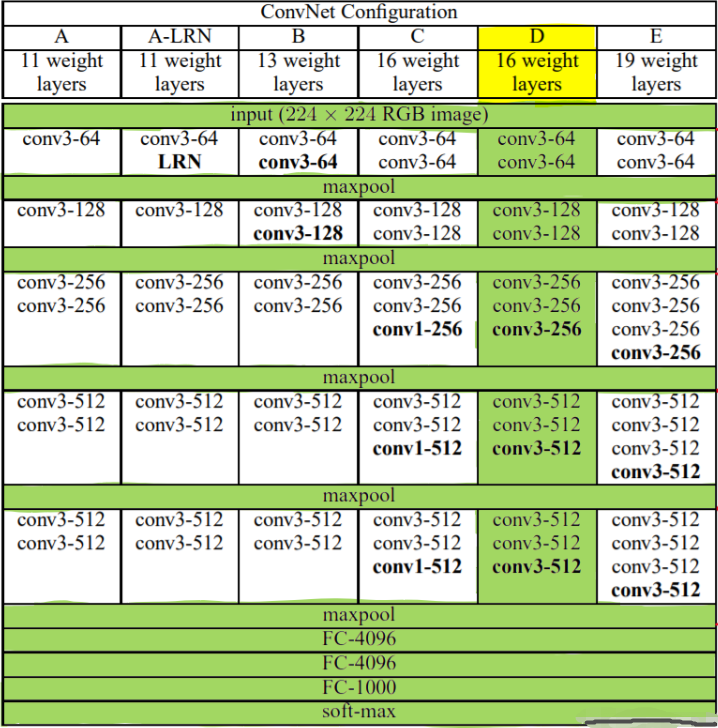Pytorch_5.7 使用重复元素的网络--VGG
VGG网络


5.7.1 VGG块
- VGG引入了Block的概念 作为模型的基础模块
import time
import torch
from torch import nn, optim
import pytorch_deep as pyd
device = torch.device('cuda' if torch.cuda.is_available() else 'cpu')
def vgg_block(num_convs, in_channels, out_channels):
blk = []
for i in range(num_convs):
if i == 0:
blk.append(nn.Conv2d(in_channels, out_channels,kernel_size=3, padding=1))
else:
blk.append(nn.Conv2d(out_channels, out_channels,kernel_size=3, padding=1))
blk.append(nn.ReLU())
blk.append(nn.MaxPool2d(kernel_size=2, stride=2)) # 这⾥会使宽⾼减半
return nn.Sequential(*blk)
实现VGG_11网络
- 8个卷积层和3个全连接
def vgg_11(conv_arch, fc_features, fc_hidden_units=4096):
net = nn.Sequential()
# 卷积层部分
for i, (num_convs, in_channels, out_channels) in enumerate(conv_arch):
# 每经过⼀个vgg_block都会使宽⾼减半
net.add_module("vgg_block_" + str(i+1),vgg_block(num_convs, in_channels, out_channels))
# 全连接层部分
net.add_module("fc", nn.Sequential(
pyd.FlattenLayer(),
nn.Linear(fc_features,fc_hidden_units),
nn.ReLU(),
nn.Dropout(0.5),
nn.Linear(fc_hidden_units,fc_hidden_units),
nn.ReLU(),
nn.Dropout(0.5),
nn.Linear(fc_hidden_units, 10)
))
return net
ratio = 8
small_conv_arch = [(1, 1, 64//ratio), (1, 64//ratio, 128//ratio),(2, 128//ratio, 256//ratio),(2, 256//ratio, 512//ratio), (2, 512//ratio,512//ratio)]
fc_features = 512 * 7 * 7 # c *
fc_hidden_units = 4096 # 任意
net = vgg_11(small_conv_arch, fc_features // ratio, fc_hidden_units //ratio)
print(net)
Sequential(
(vgg_block_1): Sequential(
(0): Conv2d(1, 8, kernel_size=(3, 3), stride=(1, 1), padding=(1, 1))
(1): ReLU()
(2): MaxPool2d(kernel_size=2, stride=2, padding=0, dilation=1, ceil_mode=False)
)
(vgg_block_2): Sequential(
(0): Conv2d(8, 16, kernel_size=(3, 3), stride=(1, 1), padding=(1, 1))
(1): ReLU()
(2): MaxPool2d(kernel_size=2, stride=2, padding=0, dilation=1, ceil_mode=False)
)
(vgg_block_3): Sequential(
(0): Conv2d(16, 32, kernel_size=(3, 3), stride=(1, 1), padding=(1, 1))
(1): ReLU()
(2): Conv2d(32, 32, kernel_size=(3, 3), stride=(1, 1), padding=(1, 1))
(3): ReLU()
(4): MaxPool2d(kernel_size=2, stride=2, padding=0, dilation=1, ceil_mode=False)
)
(vgg_block_4): Sequential(
(0): Conv2d(32, 64, kernel_size=(3, 3), stride=(1, 1), padding=(1, 1))
(1): ReLU()
(2): Conv2d(64, 64, kernel_size=(3, 3), stride=(1, 1), padding=(1, 1))
(3): ReLU()
(4): MaxPool2d(kernel_size=2, stride=2, padding=0, dilation=1, ceil_mode=False)
)
(vgg_block_5): Sequential(
(0): Conv2d(64, 64, kernel_size=(3, 3), stride=(1, 1), padding=(1, 1))
(1): ReLU()
(2): Conv2d(64, 64, kernel_size=(3, 3), stride=(1, 1), padding=(1, 1))
(3): ReLU()
(4): MaxPool2d(kernel_size=2, stride=2, padding=0, dilation=1, ceil_mode=False)
)
(fc): Sequential(
(0): FlattenLayer()
(1): Linear(in_features=3136, out_features=512, bias=True)
(2): ReLU()
(3): Dropout(p=0.5)
(4): Linear(in_features=512, out_features=512, bias=True)
(5): ReLU()
(6): Dropout(p=0.5)
(7): Linear(in_features=512, out_features=10, bias=True)
)
)
训练数据
batch_size = 32
# 如出现“out of memory”的报错信息,可减⼩batch_size或resize
train_iter, test_iter = pyd.load_data_fashion_mnist(batch_size,resize=224)
lr, num_epochs = 0.001, 5
optimizer = torch.optim.Adam(net.parameters(), lr=lr)
pyd.train_ch5(net, train_iter, test_iter, batch_size, optimizer,device, num_epochs)
training on cuda
epoch 1, loss 0.5166, train acc 0.810, test acc 0.872,time 57.6 sec
epoch 2, loss 0.1557, train acc 0.887, test acc 0.902,time 57.9 sec
epoch 3, loss 0.0916, train acc 0.900, test acc 0.907,time 57.7 sec
epoch 4, loss 0.0609, train acc 0.912, test acc 0.915,time 57.6 sec
epoch 5, loss 0.0449, train acc 0.919, test acc 0.914,time 57.4 sec
分类:
Pytorch
posted on 2020-07-17 15:46 wangxiaobei2019 阅读(379) 评论(0) 编辑 收藏 举报





【推荐】国内首个AI IDE,深度理解中文开发场景,立即下载体验Trae
【推荐】编程新体验,更懂你的AI,立即体验豆包MarsCode编程助手
【推荐】抖音旗下AI助手豆包,你的智能百科全书,全免费不限次数
【推荐】轻量又高性能的 SSH 工具 IShell:AI 加持,快人一步
· 10年+ .NET Coder 心语,封装的思维:从隐藏、稳定开始理解其本质意义
· .NET Core 中如何实现缓存的预热?
· 从 HTTP 原因短语缺失研究 HTTP/2 和 HTTP/3 的设计差异
· AI与.NET技术实操系列:向量存储与相似性搜索在 .NET 中的实现
· 基于Microsoft.Extensions.AI核心库实现RAG应用
· 10年+ .NET Coder 心语 ── 封装的思维:从隐藏、稳定开始理解其本质意义
· 地球OL攻略 —— 某应届生求职总结
· 提示词工程——AI应用必不可少的技术
· 字符编码:从基础到乱码解决
· SpringCloud带你走进微服务的世界